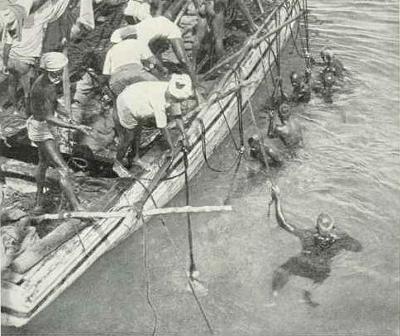第十七课 采珠业
In the New World, the sunlit waters on either side of the Isthmus of Panama were once rich in the precious shells in which pearls are found.
在新大陆巴拿马地峡的两岸太阳照耀的海水中,曾经生长着许多包裹着贵重珍珠的贝壳。
In such abundance did they yield their treasures to the Spanish conquerors,
如此丰富的资源被西班牙殖民者看中,
that in one year Seville imported six hundred and ninety-seven pounds weight of pearls, some of them of great beauty!
每一年塞维利亚都要进口重达697磅的珍珠,其中包含很多珍品。
But the hands of the gold-seekers, red with the blood of their fellow-men,
在双手沾满他们同伴鲜血的淘金者看来,
whose lovely lands, rich in the palm-tree, the plantain, and the maize, they cruelly laid waste,
这片长满棕榈树、芭蕉树和玉米的美丽土地,不过是供他们粗鲁地丢弃垃圾的荒地,

were equally unsparing beneath the waters, and equally ruthless to the miserable race of pearl-fishers.
而在静谧的水面下,采珍珠的殖民者也正做着与淘金者同样的事情。
The poor Indians, insufficiently fed, and forced into the sea by their cruel masters, oftentimes never reappeared, having fallen a helpless prey to the hungry sharks.
那些可怜的营养不良的印第安人,被他们冷酷的主人驱入海里,他们时常就成为正饿着肚子的鲨鱼的盘中餐,有去无回。
The pearl-banks themselves, unceasingly stripped of their shells, soon became exhausted. Land and water, cursed by the Spaniards' greed of gain, alike lay desolate.
采珠人会把贝壳刮干净,这种做法很快就会让产珍珠的贝壳越来越稀少。西班牙殖民者贪得无厌的行为,很快不仅耗尽了土地上的资源,同样也耗尽了海底的资源。
But it is not so in the East. There, pearl-fisheries still flourish.
不过在遥远的东方,事情还远没有结束。
At Babre in, in the Persian Gulf, renowned in times past, is the largest pearl-fishery in the world.
在那里,采珠业依然很发达。波斯湾的巴林曾经是世界著名的采珠港,现在则是世界最大的采珠场。
The annual amount of wealth which it produces is estimated at a quarter of a million sterling.



